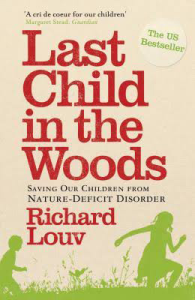Nature Deficit?
 Digital devices are everywhere. Cell phones, tablets and laptops have—especially for young people like my two daughters, aged 11 and 14—replaced cable television for entertainment. All the content you could imagine is available through YouTube, Netflix and other video streaming services. These amazing devices also allow instant communication, via Snapchat, WhatsApp and plain “old fashioned” texting, and incredible, often addictive games to suit every age group and taste.
Digital devices are everywhere. Cell phones, tablets and laptops have—especially for young people like my two daughters, aged 11 and 14—replaced cable television for entertainment. All the content you could imagine is available through YouTube, Netflix and other video streaming services. These amazing devices also allow instant communication, via Snapchat, WhatsApp and plain “old fashioned” texting, and incredible, often addictive games to suit every age group and taste.
Yet all this comes at a potential cost for our children. I often find myself worrying about how much time my girls spend on their devices.
Every generation seems to fear that its children are exposed to some terrible new influence that is going to destroy their minds and lead them astray. But we do know that today’s kids are spending a lot more time indoors. Studies show that many urban children spend almost 95 per cent of their lives indoors, much of it plugged in to those magical devices. And there’s a definite cost to that.
In his renowned book Last Child in the Woods: Saving Our Children From Nature-Deficit Disorder, Richard Louv describes a condition he calls “nature deficit disorder.” Louv suggests that a lack of unstructured play in the natural world contributes to a range of developmental and behavioural problems.
Rates of childhood anxiety, depression and obesity are on the rise. Surveys suggest that while less than five per cent of today’s children can name the five most common birds or plants in their backyard, most children, at 10 years old, can name 300 to 400 brands of consumer products.
 And what are the doctor’s orders for nature-deficit disorder? Simple: get outside! Time spent outside in nature has been shown to improve empathy and increase cognitive development. Unstructured play builds physical confidence and problem-solving skills. There is so much to learn by simply observing the natural world around us.
And what are the doctor’s orders for nature-deficit disorder? Simple: get outside! Time spent outside in nature has been shown to improve empathy and increase cognitive development. Unstructured play builds physical confidence and problem-solving skills. There is so much to learn by simply observing the natural world around us.
Early years spent developing an emotional and spiritual connection to nature often translate into a lifelong appreciation of the ecosystems we humans rely on for survival.
When I was growing up in the 1960s and 70s, nature never seemed very far away. There was a farmer’s field right across the road, and woods close by containing all manner of delights for a young child to explore. I spent endless hours there, catching tadpoles, climbing trees and playing hide and seek.
For many children today, especially those in larger centres, nature seems to be getting further and further away. “Progress” has almost turned nature into a foreign country. This is what we call a shifting baseline. The amount of intact nature experienced by each generation becomes the new “normal,” rendering the rapid and irreversible destruction of our natural world invisible.
We have an enormous responsibility to the next generation to pass on our awareness of these changes. We can do this by sharing stories about our own childhoods, going outside with them, naming the plants we can still remember, and by showing them places we played when we were young.
Children learn from the behaviour of the adults who surround them. By turning off and going outside, we show how we value time spent connecting with the natural world, without digital interruption.
When my family leaves the digital world behind and gets outside, we feel healthier, happier and more fulfilled. We come back feeling energized and more engaged with the world.
If you’re travelling with your family, and staying at an Accent Inn, why not use it as a base from which to explore all that nature has to offer? Netflix won’t go bankrupt because of your absence, but you and your family will feel happier, healthier, and more connected for it!
 If you’d like more ideas for activities to get your child out into nature, visit our website: sierraclub.bc.ca
If you’d like more ideas for activities to get your child out into nature, visit our website: sierraclub.bc.ca
Tim Pearson
Sierra Club BC